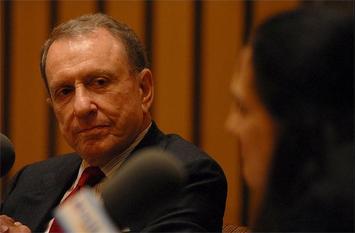
Senator Arlen Specter switched parties. A five term Senator switching parties is certainly news, but it also represents a far greater statement about the challenges facing the Republican Party in Pennsylvania going forward.
Pennsylvania has been a dependable “Blue State” in presidential races since 1988. Currently, Democrats have a 1.2 million voter registration advantage. Less than a decade ago the margin was less than 500,000. What changed over the past decade?
The changes in the political and demographic make-up of the five county Philadelphia region forced Specter’s flip. Specter’s base had been eroding as a result of other popular Democratic politicians seeking statewide and national offices and needing moderate Republicans to switch parties to support them in tough Primary Elections.
It began with now Governor Ed Rendell who faced a fierce Primary Election in 2002 against Bob Casey, Jr. – the son of a former Pennsylvania Governor. The former Philadelphia Mayor needed a strong turnout in the Philadelphia area and he managed to flip more than one hundred thousand Republicans for the primary.
Rendell defeated Casey by 162,648 votes statewide, but his victory total was 305,641 in the five county Philadelphia area where he won 81.3% of the vote and 56.5% of his total vote statewide.
The 2002 primary proved the central role of the Philadelphia region, especially the suburbs. Rendell was able to win even while losing the total vote in the other 62 counties of Pennsylvania. The shift in moderate Republicans in the suburbs to Rendell was the critical factor.
This was again the case in the general election; Rendell would carry this region by 515,000 votes on his way to winning his first term as Governor by 323,827.
The 2002 election marked a turning point in Pennsylvania politics. From that point forward no candidate for statewide office could win without carrying at least one of the four suburban Philadelphia counties. All were becoming increasingly Democratic in voter registration.
In the 2004 Primary, Arlen Specter faced conservative ex-Congressman Pat Toomey. Specter likely underestimated the impact of the change is southeast voting patterns. He was overconfident that his moderate Republican suburban base would carry the day. They did, but more narrowly than most suspected. Specter won the election by 17,146 votes statewide but he carried the southeast by 41,719 votes.
Like Rendell in 2002, Specter lost the rest of the state but won in the five county region by enough of a margin to secure victory statewide. Unlike Rendell, his total in the southeast region only accounted for 31.4% of his statewide total votes as compared to Rendell’s 56.5%.
Also, significant was the fact that he only defeated Toomey, who is far more conservative than former Senator Rick Santorum, by 34,669 votes in the four suburban counties. The moderate base was shifting to the Democrats, leaving the remnants of the GOP more conservative. This was a harbinger of Specter’s diminishing prospects as a Republican.
Specter won the primary with 166,944 votes from the southeast region. Two years earlier in the primary, Mike Fisher, the Republican candidate from Pittsburgh who was running for Governor without opposition, won 161,103 Republican votes in this region. Fisher outpolled Specter’s 2004 vote in 2 of the 5 counties. It was only the last minute support Specter received from President George W. Bush and Senator Rick Santorum that saved Specter from defeat in 2004.
In the General Election, Specter walloped his Democratic opponent Joe Hoeffel, a former southeast Congressman and Montgomery County Commissioner, by nearly 600,000. He would carry all five counties in the southeast by wide margins mainly because he had significant support from Democrats and Independents.
The trend of greater Democratic power – and Specter’s dependence on them – continued to build. In 2006, Bob Casey defeated incumbent Senator Rick Santorum by 17.4 percentage points statewide despite the fact that Santorum would spend $31 million and was the number three in Republican Senate Leadership. Casey would carry all five counties in the southeast region proving that conservative Republicans could no longer win in this critical area in a contested General Election. By 2008, Barack Obama put the icing on the cake. The President racked up huge margins in the southeast repeating what Rendell had done in 2002. The change was now complete.
It is safe to say that Arlen Specter simply could not win a Republican Primary Election in 2010. This said it is also safe to say that he would have likely won the General Election with relative ease regardless of who was the Democratic candidate. This is the dilemma that faced a Republican Party increasingly alienated from Specter, but facing increasingly stiff odds in its former suburban Philadelphia strongholds.
The question now is will the Republican Party stand with conservative Pat Toomey to challenge Democrat Arlen Specter in the General Election? With promised support from President Obama, Vice President Biden and Governor Rendell the likelihood of a primary challenge for Specter is remote in his new party.
Revenge is rarely as sweet as anticipated. It seems unlikely that a conservative Republican can win statewide without support in the Philadelphia suburbs. But data and history show that this is highly unlikely for a conservative Republican. There’s a cost to party purification. Unless the Republicans can find a way to appeal to the wayward suburban voters, it will take a major shift in the political dynamic – perhaps a more decided Democratic move to the left – to put Pennsylvania back in play.
Dennis M. Powell is president and CEO of Massey Powell an issues management consulting company located in Plymouth Meeting, PA.
Photo: KyleCassidy












